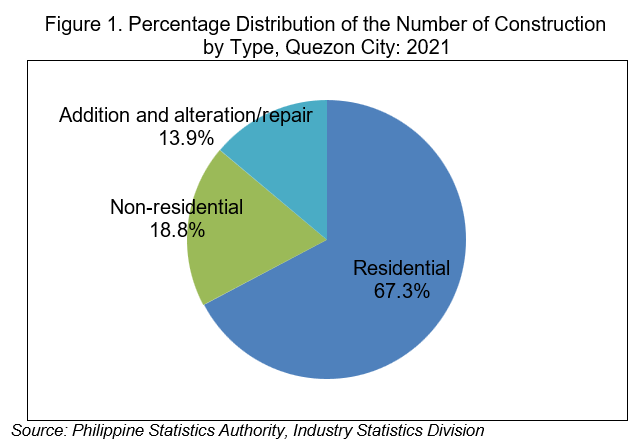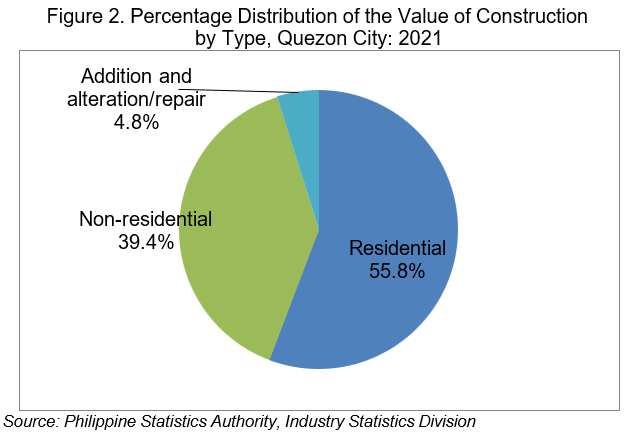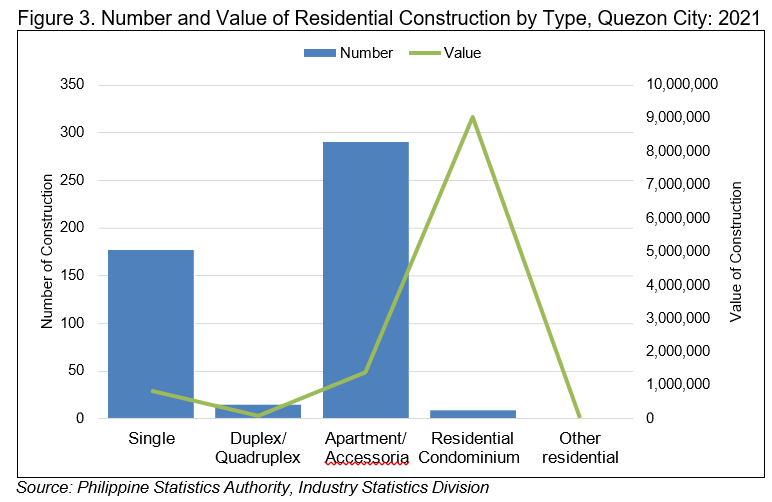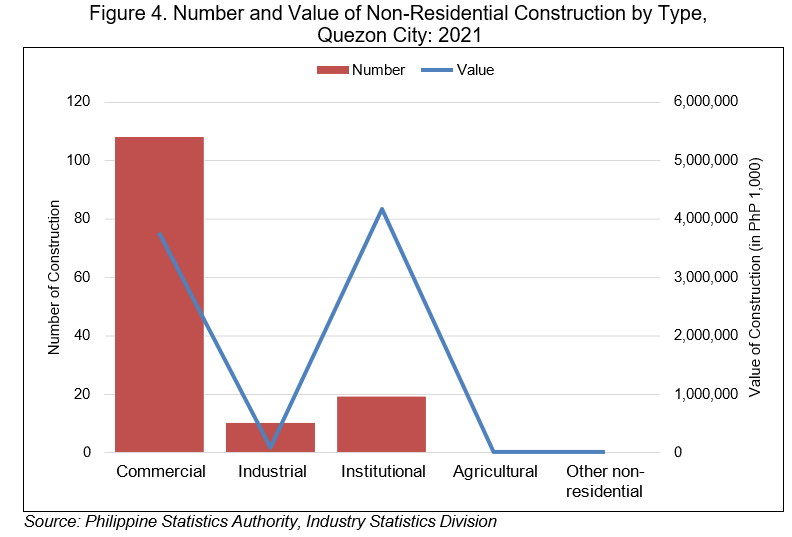Approved building permits reach 727 in 2021
In 2021, more than 700 building permits were approved in Quezon City. The total floor area was estimated at 1,160,945 square meters, with cumulative value of PhP 20.22 billion.
The average cost of construction in Quezon City—recorded at PhP 17,420.59—was PhP 1,452.29 higher than the regional average of PhP 15,968.30 per square meter.
Relative to National Capital Region (NCR), Quezon City shared 7.3 percent to the total number of constructions in the region. Quezon City ranked fourth among the 16 cities and one municipality in NCR with the highest number of approved building permits.
Table 1 shows the number, floor area, value, and the average cost per square meter of a building in NCR and Quezon City during 2021.

More than half of constructions in Quezon City are residential
Building construction in 2021 was mostly residential. Approximately seven out of every 10 approved building constructions were residential buildings. Meanwhile, non-residential building construction was recorded at 137 (18.8%). The remaining proportion was accounted for by additions and alteration/repair.
Figure 1 illustrates the percentage distribution of the number of constructions by type in Quezon City for 2021.

Consequently, residential buildings recorded the highest value with PhP 11.28 billion, followed by non-residential buildings with PhP 7.98 billion. The remainder was accounted for by additions, alteration, and repair.
Figure 2 demonstrates distribution in the value of constructions by type in Quezon City for 2021.

Cost of construction per square meter high on non-residential buildings
Non-residential construction is costly.
In 2021, the average cost per construction of non-residential buildings in Quezon City was estimated at PhP 19,718.66. The cost was also higher than the average cost of the whole city. Meanwhile, PhP 15,035.73 was spent on residential buildings on average.
Nearly 300 residential constructions apartment/accessoria
Residential buildings are classified into five: (a) single;(b) duplex/quadruplex; (c) apartment/accessoria; (d) residential condominium; and (e) other residential.
However, the value of construction in residential buildings was highest in condominiums, with a cumulative value of 9.03 billion, or 80.1 percent of the total value of residential construction in Quezon City. The cost of construction per square meter in residential condominiums averaged PhP 17,365.77.
Figure 3 presents the number and value of residential buildings by its type in Quezon City during 2021.

Majority of non-residential constructions are commercial
There are five classifications of non-residential building construction, namely: (a) commercial; (b) industrial; (c) institutional; (d) agricultural; and (e) other non-residential.
In Quezon City, commercial buildings had the highest number of constructions, with 108 applications, or 78.8 percent of the total number of non-residential building constructions. Other types of non-residential buildings, like institutional and industrial, had only 19 and 10 applications, respectively.
In contrast, institutional buildings recorded the highest cumulative value of more than four billion. Moreover, the average cost of construction in these buildings reported to be the highest, at PhP 26,260.97, which was about PhP 10,000 higher than that commercial buildings.
The figure on the next page shows the number and value of residential buildings by its type in Quezon City during 2021.

SGD HELEN L. ADOLACION
(Supervising Statistical Specialist)
Officer-in-Charge
TECHNICAL NOTES
Construction Statistics from Approved Building Permits
I. Introduction
I.1. Introduction
The Philippine Statistics Authority (PSA) serves as the central statistical authority of the government on primary data collection which includes the consolidation of selected administrative recording systems. Construction statistics from approved building permits is one of the data generated by PSA based on administrative records. It is compiled by PSA from the copies of approved building permits issued by the Local Building Officials (LBOs) of the Local Government Units (LGUs).
However, the approved building permits issued by LBOs is just one of the sources of construction statistics. Other sources of construction statistics are the surveys of construction establishments and enterprises conducted by the PSA, and the administrative-based data from the Department of Public Works and Highways (DPWH) and the Commission on Audit.
This Special Release presents the preliminary data on construction statistics from approved building permits for the third quarter of 2023. Data are presented at the regional, provincial and/or Highly Urbanized City (HUC) levels with monthly and quarterly disaggregation.
I.2. Objectives
Construction statistics from approved building permits aim to provide monthly administrative-based data on building constructions at the municipality level nationwide. Statistics generated are the following:
1. number of units/buildings
2. floor area of the buildings
3. types of construction
4. value of construction
I.3. Historical Background
The collection of approved building permit forms started in 1977 when the then National Census and Statistics Office (NCSO) (now part of the PSA) and the Ministry of Local Government and Community Development entered into an informal agreement in 1976 to implement the provisions of the National Building Code (NBC) and to monitor the building permit forms.
Later, on 11 July 1979, a Memorandum of Agreement (MOA) between the NCSO and the former Ministry of Public Works, Transportation and Communication (MPWTC) (now the DPWH) defined the agencies’ responsibilities in the generation of construction statistics. The NCSO was responsible for the collection, processing, analysis, and dissemination of construction statistics, while MPWTC shouldered the printing of the building permit forms from 1980 onwards.
In 1993, a Joint Memorandum Circular was issued by the Department of Interior and Local Government and the DPWH defining the duties and responsibilities of the municipal/city engineers relative to the implementation of the NBC and in the production of construction statistics from approved building permits. As a result, the printing of the building permits and certificate of completion forms became the responsibility of the LBOs.
On 15 July 2005, the DPWH through the National Building Code Development Office (NBCDO) issued Memorandum Circular No. 01 series of 2005 instructing all LBOs to implement the revised Implementing Rules and Regulations (IRR) including the use of the new building permit form.
The building permit form under the old IRR is valid for use by LGUs until today.
I.4. Scope and Coverage
Construction statistics presented in this special release are based on the approved building permits on new constructions, additions, and alterations and repairs of existing residential and non-residential buildings, and other structures, which are proposed to be constructed in different cities/municipalities of the country.
I.5. Geographic Classification
For the third quarter of 2023, building constructions are classified and presented by geographic area using the Philippine Standard Geographic Classification (PSGC) as of December 2022.
II. Data Collection
II.1. Data Collection
The collection of the approved building permits from the LBOs is done within the first five working days after each reference month by a PSA field staff.
II.2. Sources of Data
Construction statistics are compiled by the PSA from the copies of original application forms of approved building permits as well as from the demolition and fencing permits collected every month by PSA field personnel from the offices of LBOs nationwide.
II.3. Statistics Generated
Construction statistics generated from approved building permits provide monthly data on building construction at the regional and provincial levels. The statistics generated are the following:
1. number of constructions
2. floor area
3. type of construction
4. value of construction
Aside from the preliminary tables posted in the PSA website, the annual, quarterly, and monthly statistical tables at the municipality level by type of construction are available in OpenStat.
II.4. Limitations of Data
Data on building constructions are based on approved applications for construction during the reference period and not on the construction work completed during the reference period.
The completeness of construction data relies on the approved applications filed in the LBOs. Hence, building constructions without approved building permits are not part of the tabulation of data.
III. Concepts and Definitions of Terms
The definition of terms is adopted from the Revised and Updated IRR of the National Building Code.
Building permit is a written authorization granted by the LBO to an applicant allowing him to proceed with the construction of a specific project after plans, specifications, and other pertinent documents have been found to be in conformity with the National Building Code (PD 1096).
Building refers to any independent, free-standing structure comprised of one or more rooms or other spaces, covered by a roof and enclosed with external walls or dividing walls, which extend from the foundation to the roof.
Construction refers to all on-site work done from site preparation, excavation, foundation, assembly of all the components and installation of utilities, machineries, and equipment of buildings/structures.
Residential building is a building for which its major parts or more than half of its gross floor area is built for dwelling purposes. This type of building can be of the single type, duplex, apartment and/or accessoria, and residential condominium.
Single house is a complete structure intended for a single family or household, i.e., bungalow, 2-storey house, nipa hut, etc.
Duplex house is a structure intended for two households, with complete living facilities for each; it is a single structure divided into two dwelling units by a wall extending from the floor to the ceiling.
Apartment is a structure, usually of two storeys, made up of independent living quarters, with independent entrances from internal walls and courts.
Accesoria is a one or two-floor structure divided into several dwelling units, each dwelling unit having its own separate entrance from the outside.
Residential condominium is a structure, usually of several storeys, consisting of multiple dwelling units.
Other residential construction consists of school or company staff houses, living quarters for drivers and maids, and guardhouses.
Non-residential building includes commercial, industrial, agricultural, and institutional buildings.
Commercial buildings refer to office buildings and all buildings which are intended for use primarily in wholesale, retail, and service trades; i.e., stores, hotels, restaurants, banks, disco houses, etc.
Industrial buildings are buildings used to house the production, assembly, and warehousing activities of industrial establishments; i.e., factories, plants, mills, repair shops, machine shops, printing press, storage plants, electric generating plants.
Institutional buildings are buildings which primarily engaged in providing educational instructions and hospital/health care; ports, airports and other government buildings; i.e., schools, museums, libraries, sanitaria, churches, hospitals.
Agricultural buildings are buildings used to house livestock, plants, and agricultural products such as barns, poultry houses, piggeries, stables, greenhouses, and grain mills.
Other non-building constructions include cemetery structures, street furniture, waiting sheds, communication towers, etc.
Addition refers to any new construction which increases the height or area of an existing building/structure.
Repair is a remedial work done on any damaged or deteriorated portion/s of a building/structure to restore its original condition.
Renovation is any physical change made on structures to increase their value and quality.
Alteration is a construction in a building/structure involving changes in the materials used, partitioning and location/size of openings, structural parts, existing utilities, and equipment but does not increase the overall area thereof.
Conversion is a change in the use or occupancy of structure or any portion thereof, which has different requirements.
Demolitions refer to the systematic dismantling or destruction of a building/structure, in whole or in part.
Street furniture are street structures consisting of monuments, waiting sheds, benches, plant boxes, lampposts, electric poles, and telephone poles.
Floor area of building refers to the sum of the area of each floor of the building measured to the outer surface of the outer walls including the area of lobbies, cellars, elevator shafts, and all communal spaces in multi-dwellings. Areas of balconies are excluded.
Total value of construction refers to the sum of the cost of building, electrical, mechanical, plumbing, and others. The value is derived from the approved building permit and represents the estimated value of the building or structure when completed.
IV. Dissemination of Results and Revision
IV.1 Dissemination
Preliminary results of construction statistics are made public in the form of Quarterly Special Releases. The Quarterly Special Releases are reports containing the preliminary results of construction statistics submitted within the cut-off dates for each month. Results are posted 45 days after the reference quarter in the PSA website. The statistical tables are also available in OpenStat.
IV.2 Revision
All documents received after the cut-off date, which is 40 days after the reference quarter, are included in the generation of revised results. The revised data of the previous quarter are reported during the release of the preliminary report of the current quarter. Revisions are made for the previous quarters until the annual report is released six months after the reference year.
V. Citation
Philippine Statistics Authority. (November 2023). Technical Notes on the Construction Statistics from Approved Building Permits. https://psa.gov.ph/technical- notes/buildingpermit
VI. Contact Information
John Paul C. Sacop
(Supervising Statistical Specialist) Officer-in-Charge
Industry Statistics Division (632) 8376-2060
non-mfg.staff@psa.gov.ph isd.staff@psa.gov.ph
For data request, you may contact the:
Knowledge Management and Communications Division (632) 8462-6600 local 839
info@psa.gov.ph
